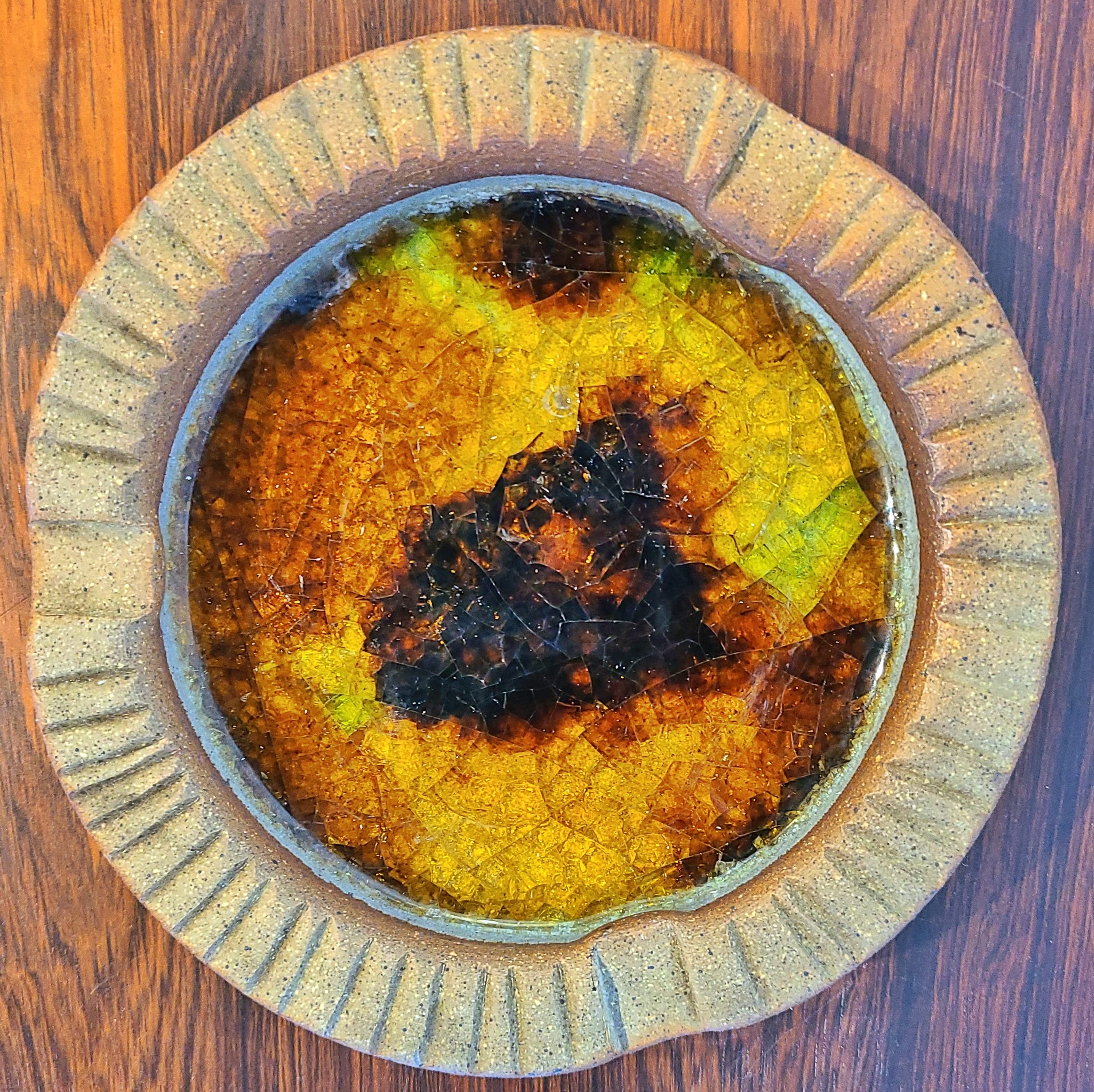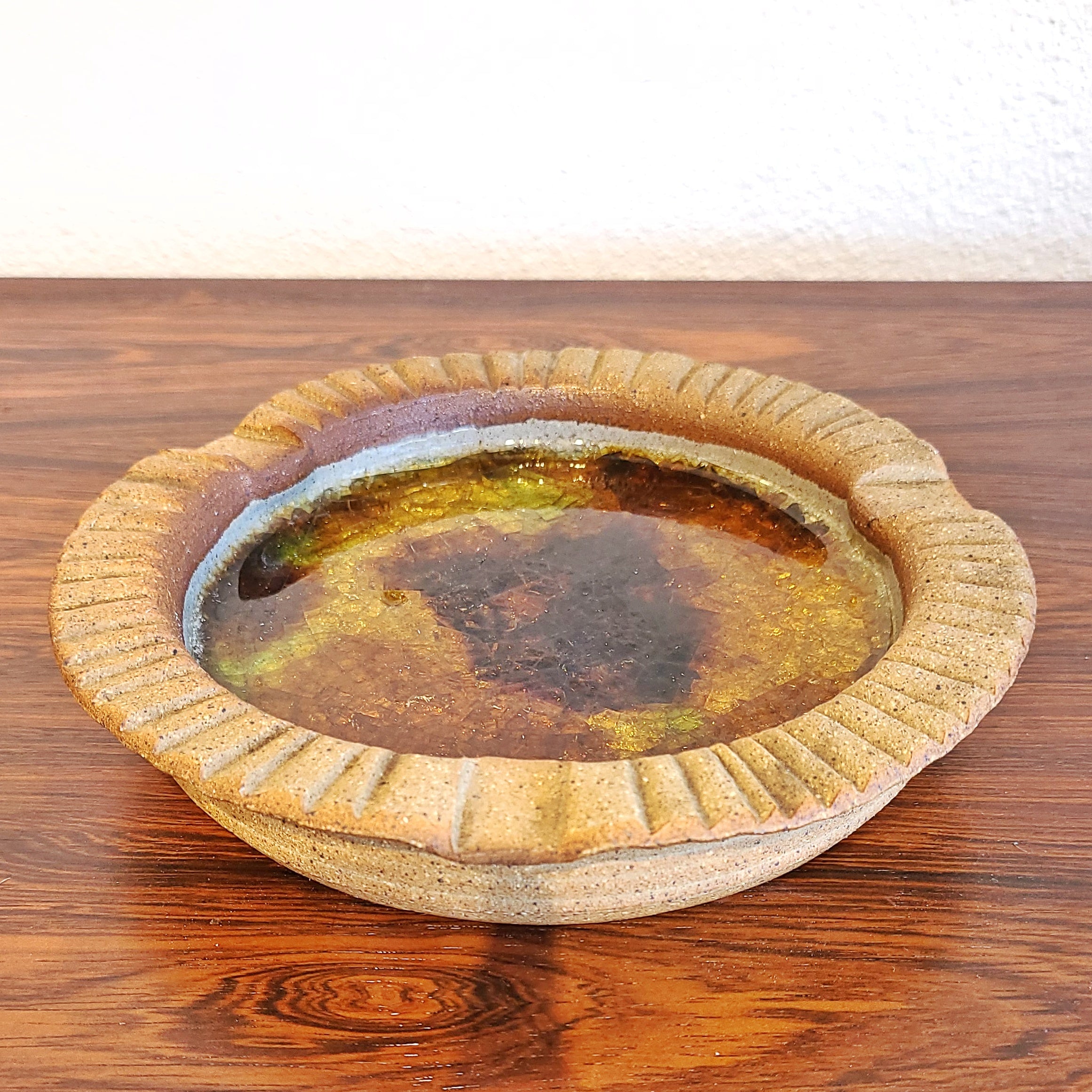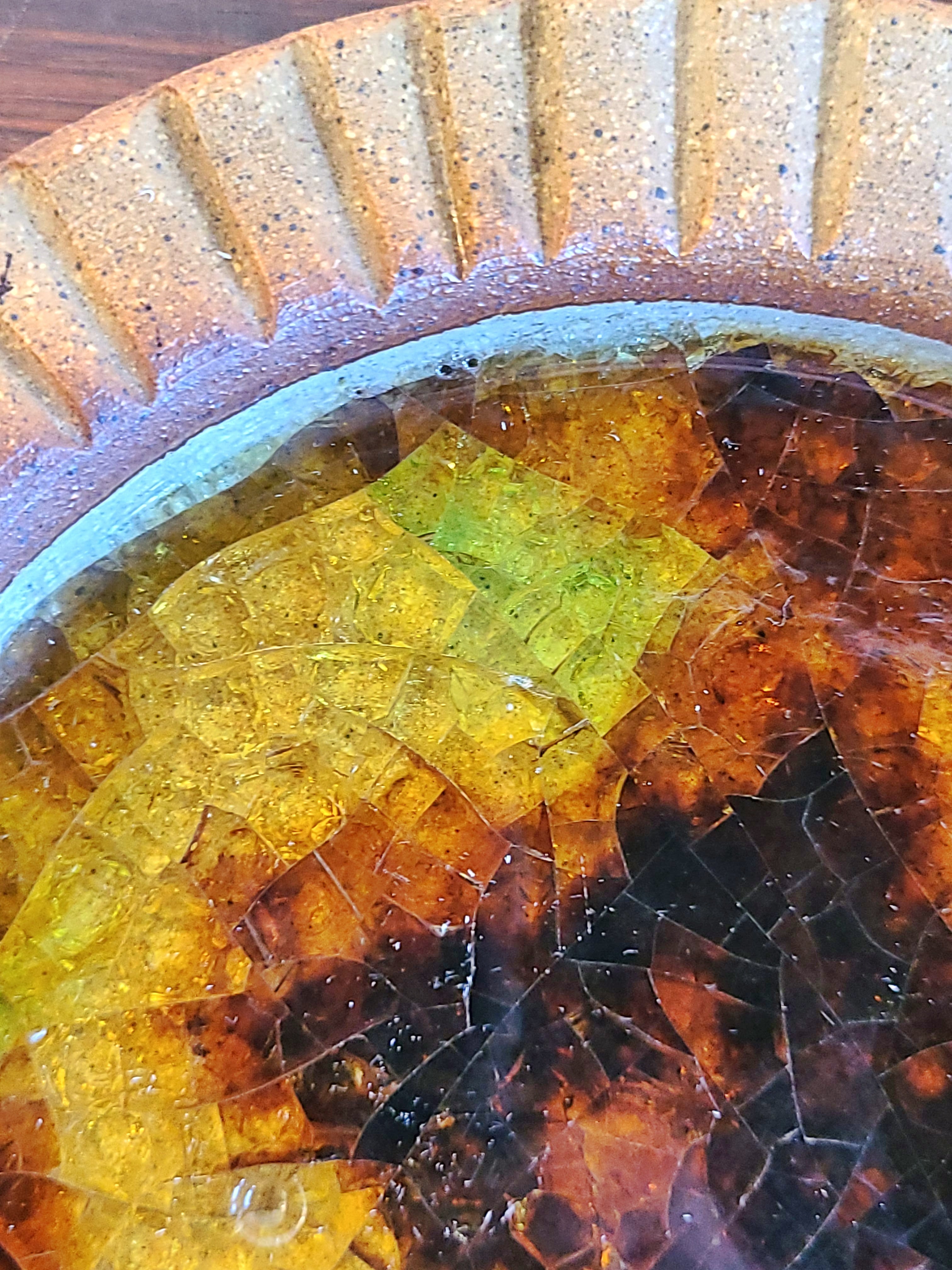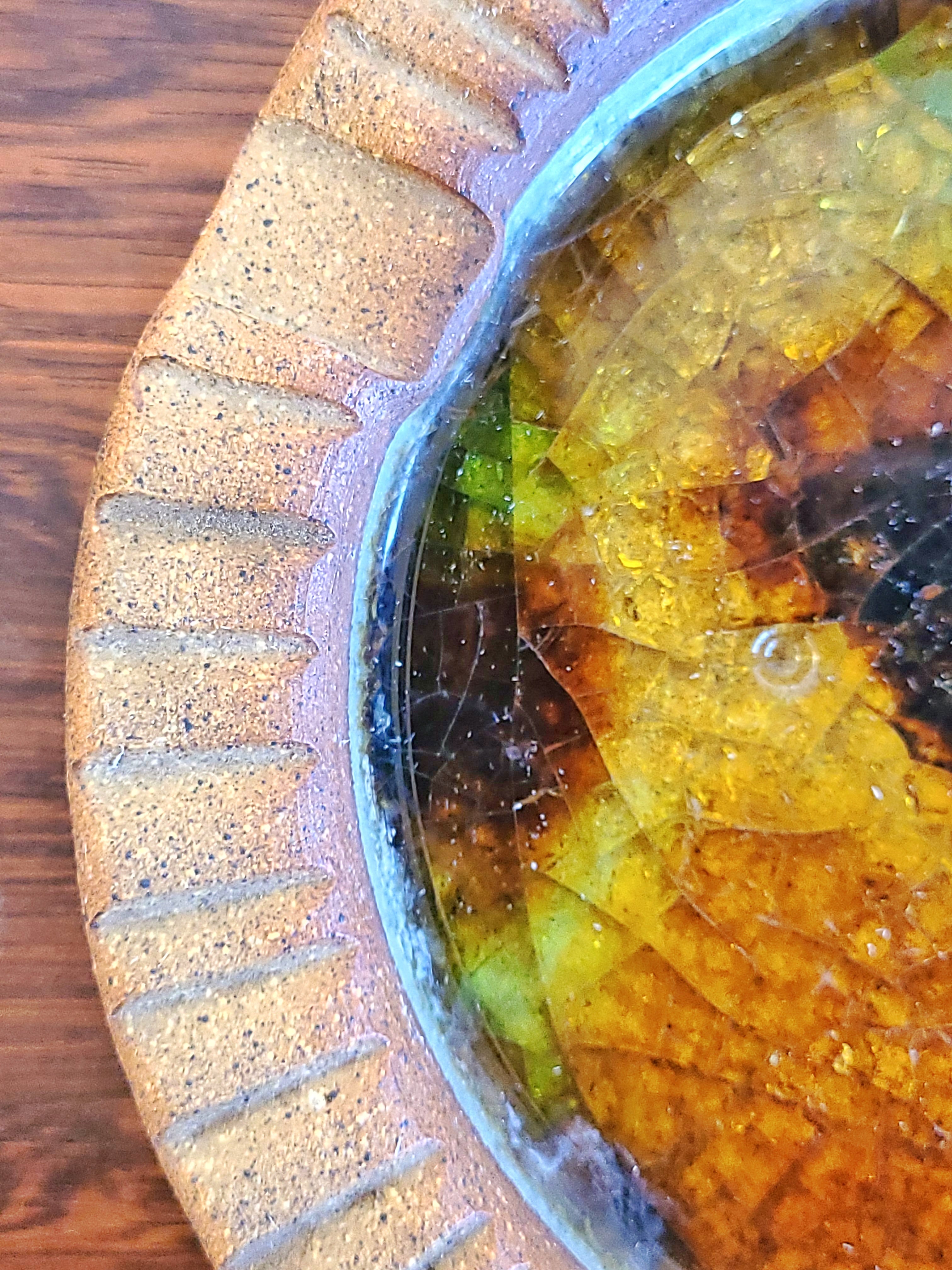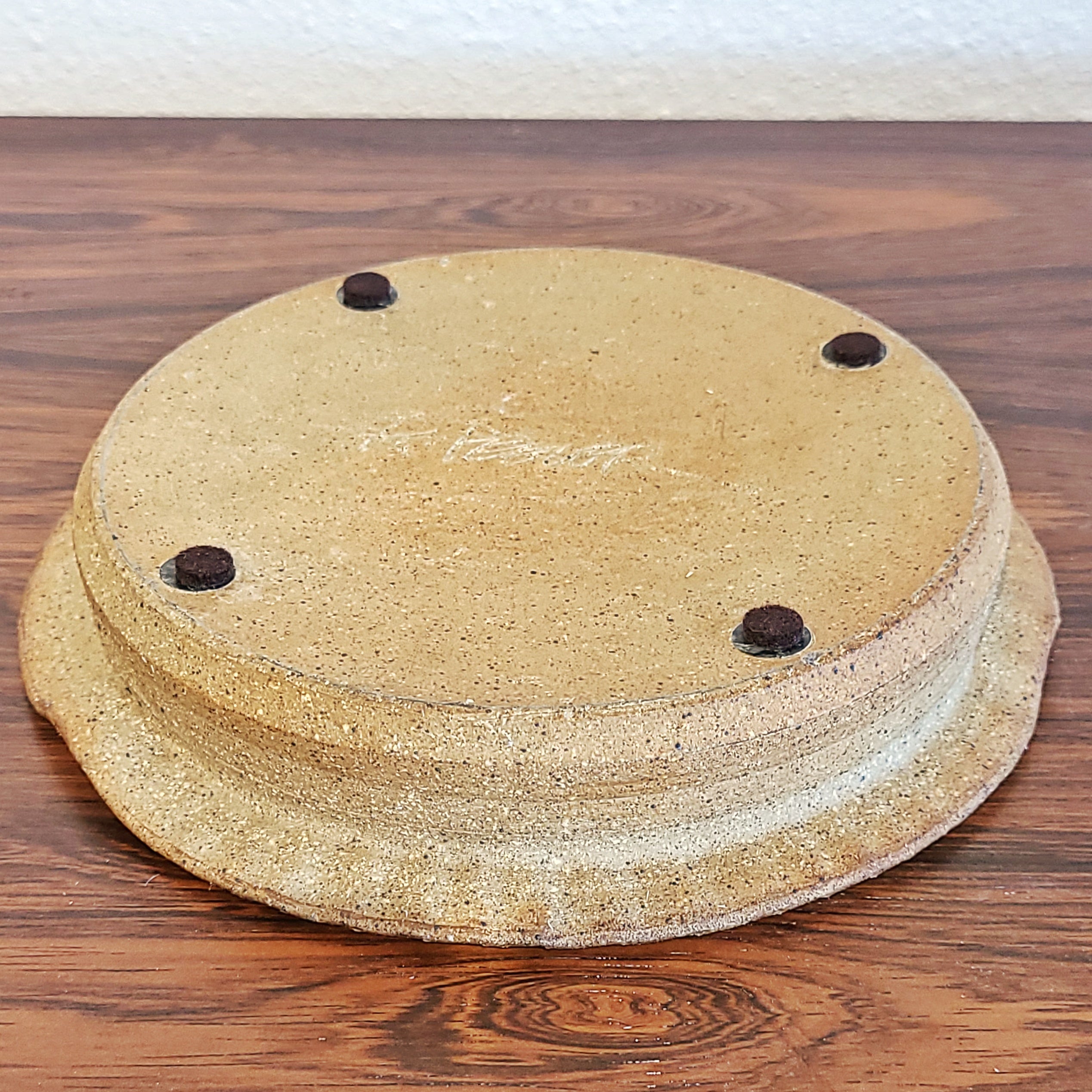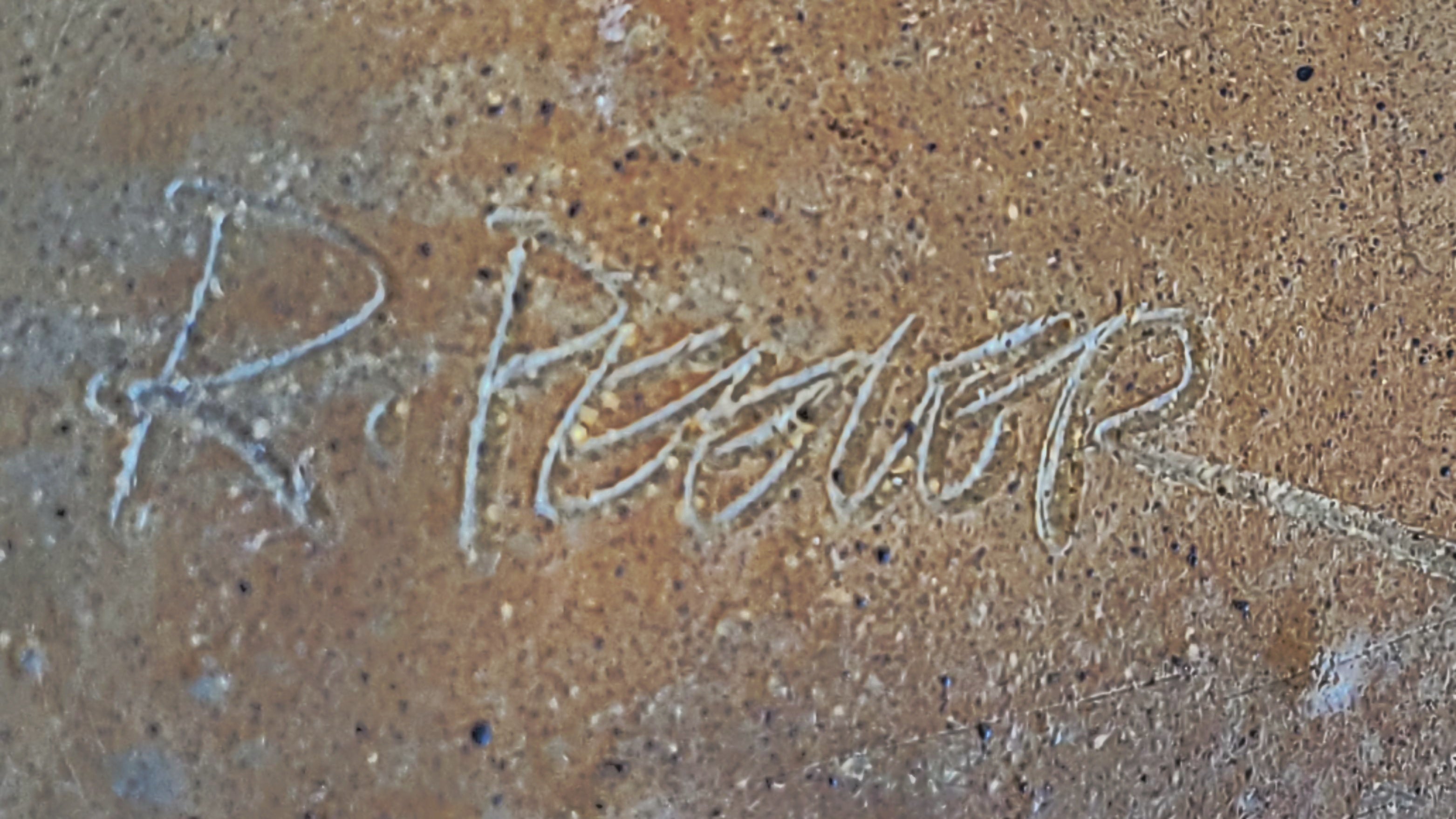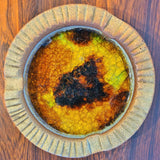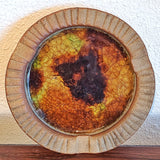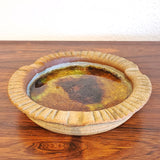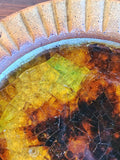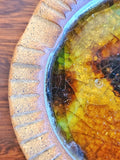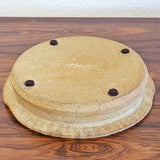A rare stoneware ashtray with a fused crackle glass interior by well-known Indiana ceramic artist Richard Peeler. Peeler's characteristic stoneware has been left unglazed except for the multi-colored glass in shades of orange, yellow, and green that has been fused in the kiln to form a visually interesting crackled glass surface on the interior of the bowl.
RICHARD (1926-1998) AND MARJ (1926-2017) PEELER met in 1940 as sophomore art students at Indianapolis Arsenal Tech High School. As artists, Richard and Marj Peeler were prominent members of the first generation of modern American ceramic artists who transformed the traditional craft of vessel making into an academic discipline and an art form in the United States. They admired the folk traditions of a time when hand-made ceramics were functional and had no industrial alternatives, but In an age when plastic and metal could do the same job better and cheaper, they adapted by making useful art for the common man. The couple's participation in the formation of the National Council on Education for the Ceramic Arts (the professional organization for ceramics) created the foundation of professional standards for the medium. Travels to Japan to make films about Japanese traditions helped introduce ideas about ceramic aesthetics and provided a point of departure for serious artists at a time when the United States had few traditions of its own.
After they graduated from Tech High School in 1944, at the very end of the war, Richard was drafted and served in the Army of Occupation of Germany. At the age of 19, he became a Master Sergeant in charge of 35 men who made out a 2 million-dollar payroll each month. Marj went on to earn an Associate's Degree in Fine Arts from the University of Minnesota in 1947, and after his release from the Army, Richard received his degree in art from DePauw University in 1949. There were not many ceramics programs in colleges and universities in the 1940s so their initial training in ceramics was minimal. When Richard got his AB degree at DePauw University in 1949, he had been struggling to teach himself how to throw. Finally, in 1953, he met J. J. Marek, a sixth-generation Czech potter who taught him how to throw. He later completed his M.A.T. degree in 1960 at Indiana University studying with Karl Martz.
The couple was married on January 25, 1948, and moved to Reelsville, IN in rural Putnam County in 1950. There they would remain for the rest of their lives. Interestingly, the couple built one of the earliest rammed-earth homes made largely of the soil and clay found on the property, and constructed with their own hands to create a beautiful home, gardens, and studio, and showing at every turn Richard and Marj's concern that art should be an integral part of life. Richard began teaching art at his first alma mater, Arsenal Tech High School, from which he had graduated only four years earlier. He taught art at Arsenal Tech for seven years before returning to DePauw University in 1958 to teach ceramics, sculpture, and photography.
In 1966 the Peelers built a pottery production studio on the grounds of their home and dubbed it "Peeler Pottery." That same year, Richard spent the spring term as a visiting lecturer at Kyoto City College of Fine Arts in Japan. While he taught many artistic mediums, It was Peeler’s influence that stimulated the expansion of DePauw’s ceramic offerings. he developed a loyal following among both students and customers of his high-fired stoneware. A prolific artistic duo, the Peelers welcomed many DePauw students and visitors to their home and studio for more than 40 years. Richard was always known as a great source of information, always willing to share what he knew with other potters. Many potters in Indiana have used the clay he sold, which came from a mine near Clay City, Indiana. The Peelers worked together in clay since 1948, starting with a one-cubic-foot kiln which they used to fire ceramic jewelry, making a living by firing it each day. There were not many ceramics programs in colleges and universities in the 1940s so their initial training in ceramics was minimal by the time Richard got his AB degree at DePauw University in 1949. he had struggled to teach himself to throw in the early years, finally meeting J. J. 'Jerry' Marek, a sixth-generation Czech potter, who taught him how to throw in 1953. He later completed his M.A.T. degree in 1960 at Indiana University studying with Karl Martz.
From 1965-68, The Peelers produced eight educational films entitled the Ceramic Art Films Series for McGraw-Hill which were widely used for ceramic instruction. The films examine ceramic history and techniques, Japanese influence on ceramics, and leading American and Japanese potters. Peeler was an author of numerous articles in Ceramics Monthly, appearing on the cover twice. He served as President of the National Council on Education for the Ceramics Arts, Director of the Indiana Artists-Craftsmen, and the Indiana Potters Guild.
Richard Peeler retired early from the DePauw faculty in 1972, and Richard and Marj became full-time potters, working as a team producing utilitarian and artistic pottery out of the Peeler Pottery Studio located on their property. Richard built a 40 cubic foot catenary arch kiln, which they fired to cone 10 (2380º F) reduction. Most of their pottery was turned on the potter’s wheel using stoneware clay. However, they also made a goodly number of hand-built pots and sculptures and one-of-a-kind items. The surfaces of their pieces are often highly carved with slip trailing used to create more depth. Their main production pottery was utilitarian and relatively small because the small items fit into wasted space around the larger pieces. Therefore, the kiln was always packed full before firing it. Tiny items, which they sold for a small price, added up to enough extra money to pay for the fuel. At the height of production, the Peelers reported making 10,000 pottery pieces a year. They often worked on each other’s pieces, glazing together, stacking kilns together, and packing and shipping together. Counted among their influences are Charles Lakofsky, Frans Wildenhain, Toshiko Takaezu, William Wyman, Vivilka and Otto Heino, Warren Mackenzie, and several Japanese potters. The couple worked for more than a quarter-century as full-time potters until Richard’s death in 1998. Peeler pottery is now found in collections throughout the world. The Peeler Arts Center at DePauw University in Greencastle is named for Richard Peeler. Designed by internationally-acclaimed architect Carlos Jiménez, the Richard E. Peeler Art Center was dedicated on October 11, 2002. The building is the first in DePauw’s history to be dedicated primarily to the teaching, creation, and display of art.
Details
- Dimensions
- 7.75ʺW × 7.75ʺD × 1.25ʺH
- Styles
- Abstract
- Boho Chic
- Mid-Century Modern
- Period
- 1960s
- Place of Origin
- United States of America
- Item Type
- Vintage, Antique or Pre-owned
- Materials
- Glass
- Stoneware
- Condition
- Good Condition, Original Condition Unaltered, Some Imperfections
- Color
- Tan
- Condition Notes
- Very Light Surface Scratches to Glass

